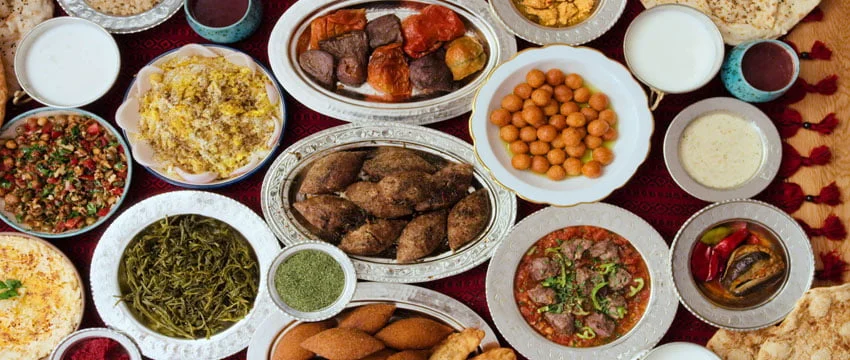Take Me to The Turkmenistan Recipes
Turkmenistan, a Central Asian gem, boasts a rich history shaped by empires, trade routes, and nomadic traditions. Turkmenistan Cuisine is a product of the country’s geographical position, its golden deserts, impressive mountain ranges and the continental climate.
Situated between Kazakhstan to the north and Iran to the south, this landlocked country offers mesmerizing scenic beauty and ancient history. The main industrial activity revolves around gas and oil production, cotton farming, and textile manufacturing. With a population of about six million, the rich tapestry of Turkmenistan’s culture is closely intertwines with its sumptuous cuisine.
Turkmenistan is located to the northeast of Iran and to the southwest of Uzbekistan. The majestic Kopet Dag mountain range and the Karakum Desert mark the golden landscapes. The subtropical desert climate fosters the growth of cotton, a significant industrial activity in the region.
The 6,000,000 Turkmen people cultivate a unique culinary heritage that they preserve through generations.
Turkmenistan Cuisine – Key Takeaways
- Turkmenistan is in Central Asia, boasting a rich historical tapestry.
- The climate and geography have directly influenced its culinary offerings.
- Cotton farming is a primary industry in the region.
- The cuisine incorporates a myriad of flavors, often centered around meats and grains.
- Traditional meals often have strong communal and celebratory aspects.
- Turkmen dishes are deeply rooted in its nomadic and agricultural heritage.
Take Me to The Turkmenistan Recipes
You may also be interested in the following articles
- North and South American Cuisine – A Culinary Expedition
- Europe Cuisine: Savor the Continent’s Best Culinary Secrets!
- African Cuisine: Discover the Bold Flavors & Global Charm!
- Asian Cuisine Unlock its Secrets – Taste, Health & Global Influence!
Where is Turkmenistan?

Turkmenistan is located in the southwest of the Central Asia region. It is bordered by Kazakhstan to the northwest, Uzbekistan to the north and east, Afghanistan to the southeast, Iran to the south, and the Caspian Sea to the west.

Index to Contents
- Take Me to The Turkmenistan Recipes
- Interesting Facts about Turkmenistan
- The History of Turkmenistan and the Impact it has had on the Food
- How Turkmenistan‘s Climate and Geography has Influenced Turkmenistan‘s Cuisine
- Understanding the Essence of Turkmenistan Cuisine
- Food Of Turkmenistan
- Turkmenistan Culinary Traditions
- How Healthy is Turkmenistan Food?
- The Most Popular Turkmenistan Food
- Great Turkmenistan Food Recipes to try at Home
- Conclusion
- FAQ’s
You may also be interested in the following articles
- North and South American Cuisine – A Culinary Expedition
- Europe Cuisine: Savor the Continent’s Best Culinary Secrets!
- African Cuisine: Discover the Bold Flavors & Global Charm!
- Asian Cuisine Unlock its Secrets – Taste, Health & Global Influence!
Savor iconic Turkmenistan Food Recipes – Click on each tantalizing picture to open up the Recipe
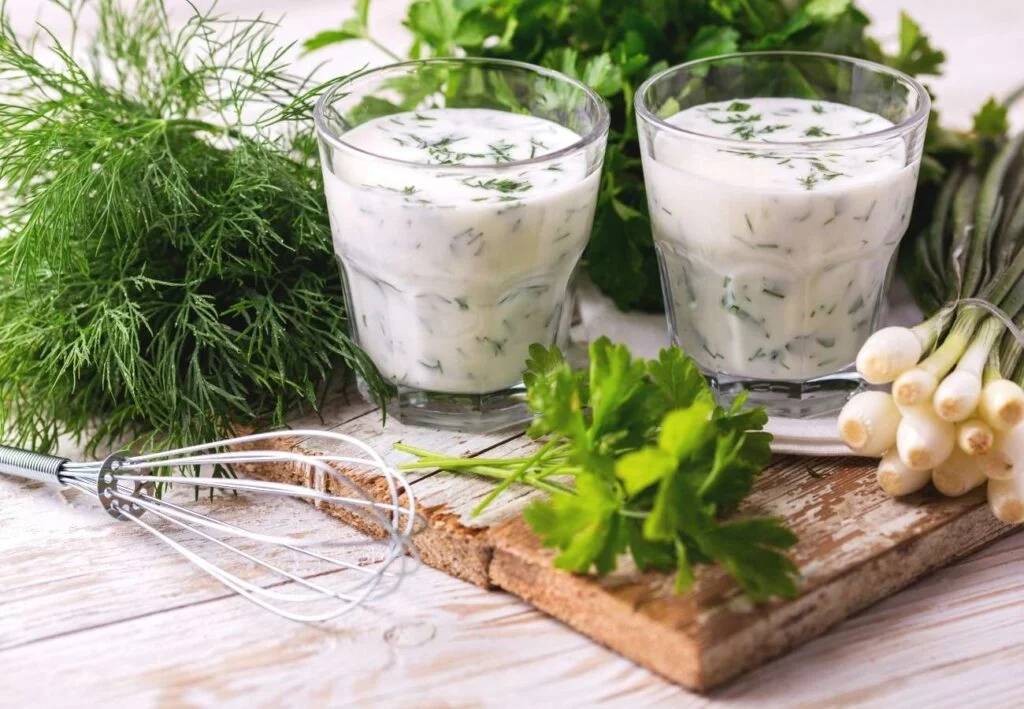



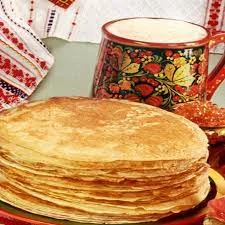
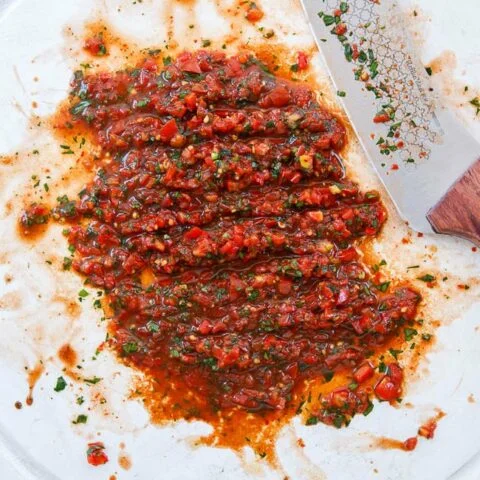
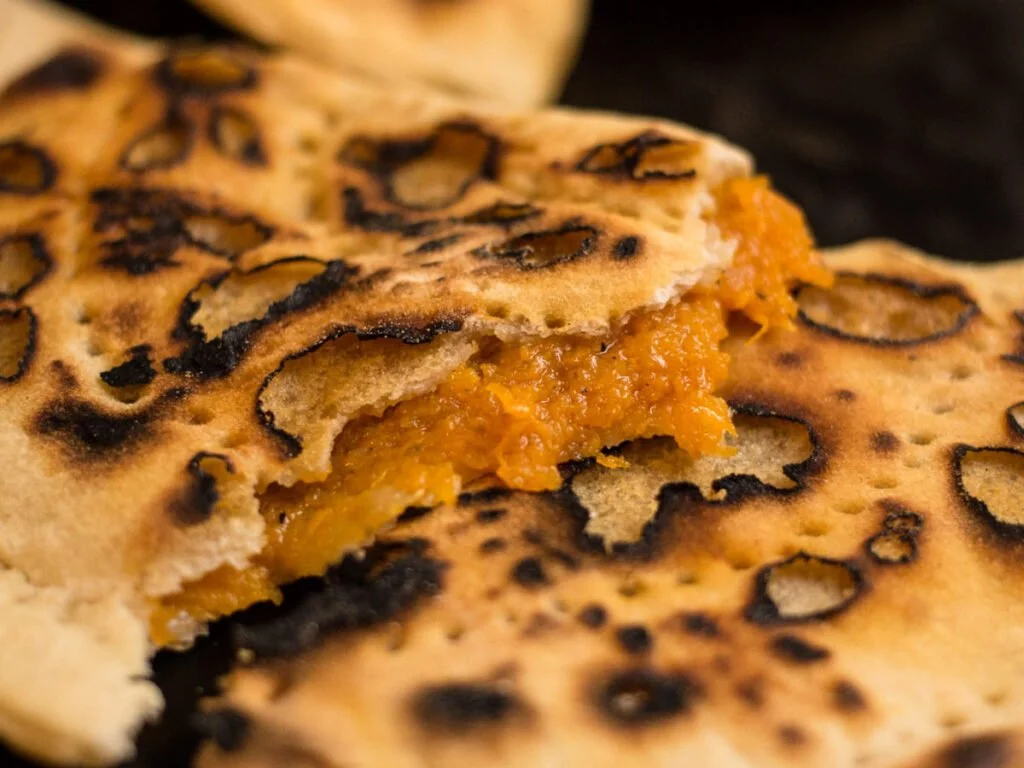
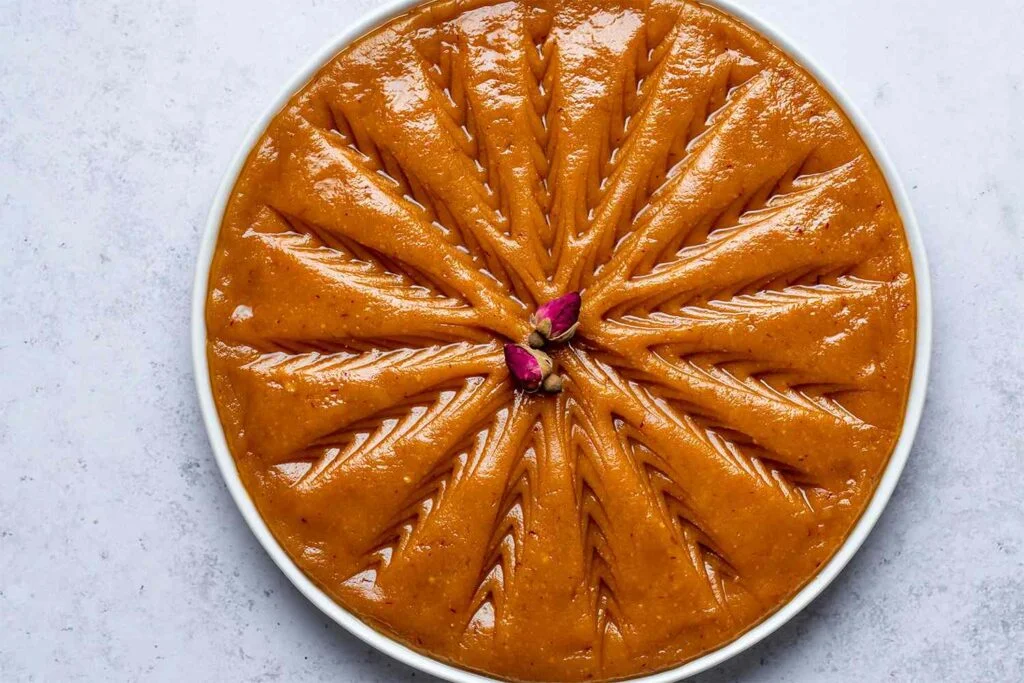


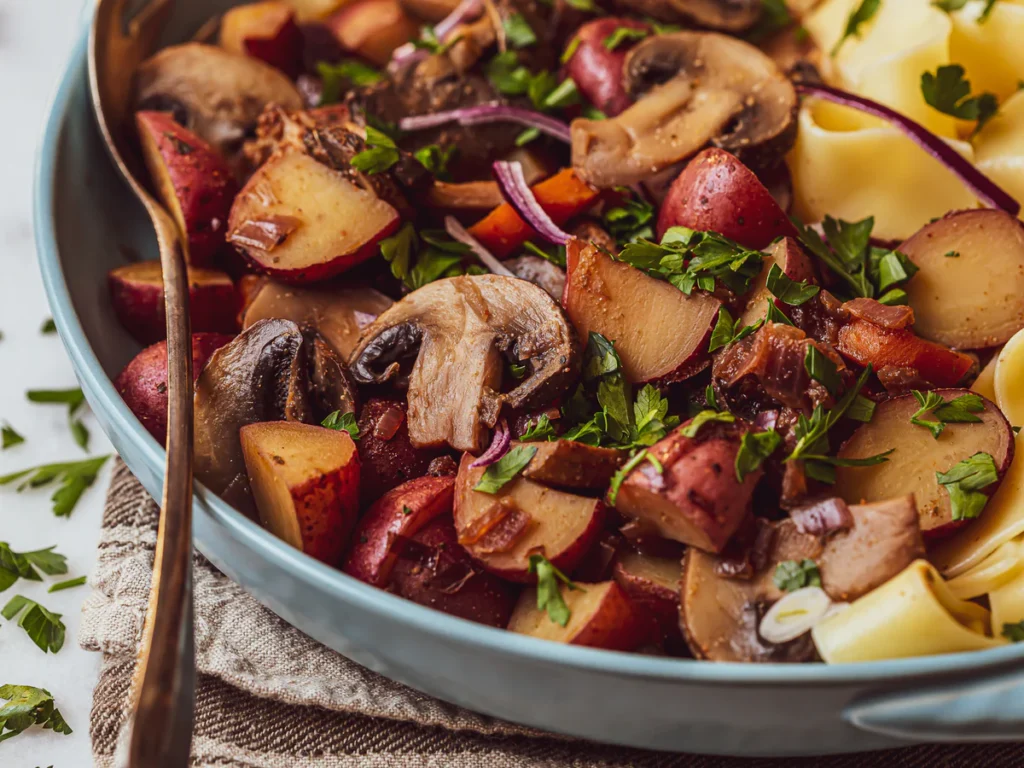

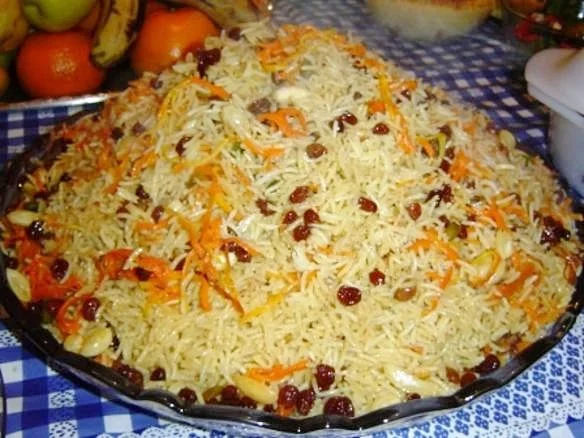

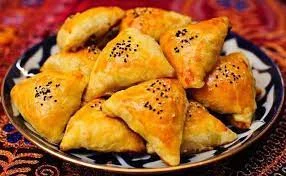

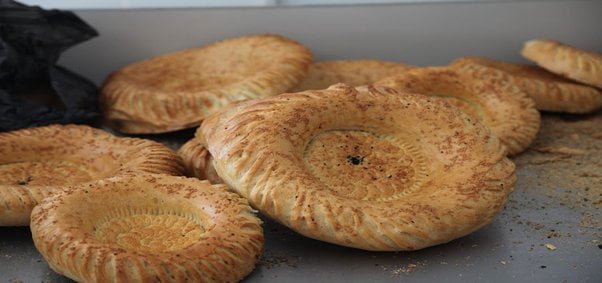

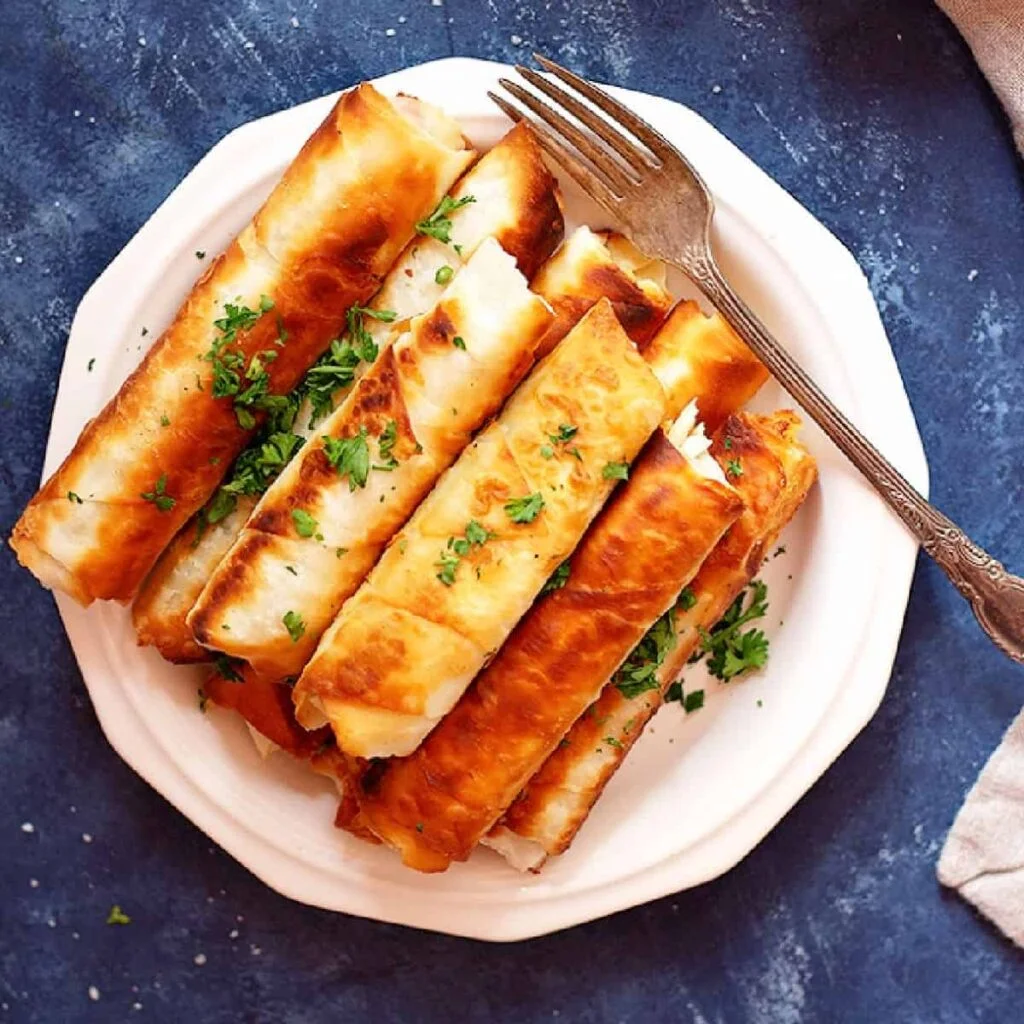
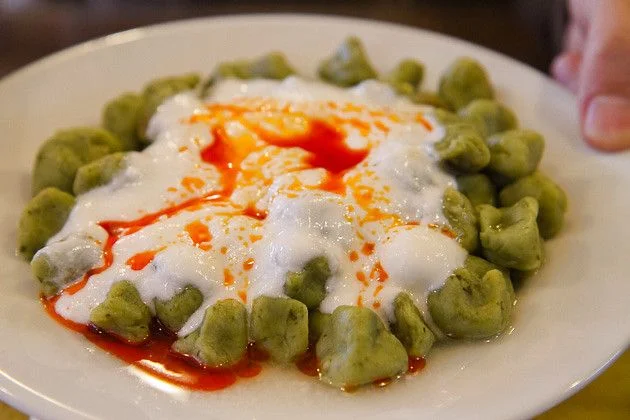
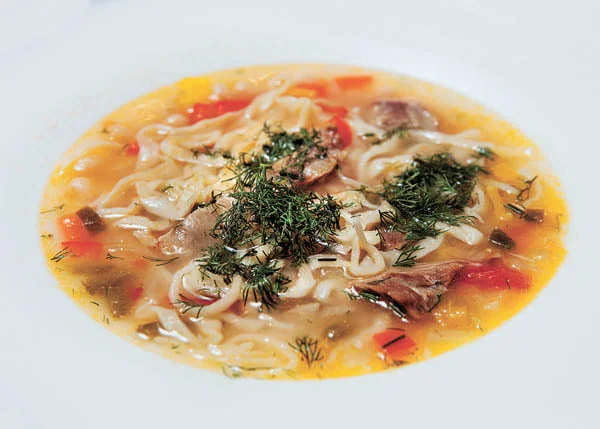
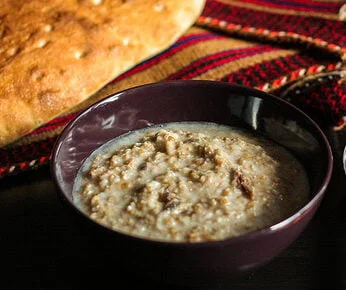
Interesting Facts about Turkmenistan
Turkmenistan is like stepping into a magical land – full of wonders and a bit tricky to figure out. It’s a place where you can always expect a surprise, like a cool secret waiting to be discovered at every turn.
Turkmenistan: The Hidden Gem
Did you know that Turkmenistan is like the world’s secret clubhouse?
Not many folks visit, in fact it is the least visited country on the planet!
Nope, it’s because getting there is like solving a puzzle – you need a special visa pass. But once you’re in, get ready for some serious fun because the locals are as friendly as puppies at a dog park!
Turkmenistan: The Land of Sand and Surprises

Turkmenistan is like 70% pure, unadulterated desert. Imagine tons of sand, and then some more sand. But here’s the kicker – this whole place used to be a giant sea millions of years ago!
When you take a stroll in the desert, keep an eye out for cool stuff like ancient seashell fossils. It’s like Mother Nature left a treasure hunt for us.
The Oopsie-Daisy Gas Crater

Picture this: a massive hole in the desert with flames shooting out, day and night. They call it the “Gate of Hell,” and it’s not a natural wonder. Back in 1971, some Soviet scientists were drilling for gas, and oopsie-daisy, they set it on fire, thinking it’d burn out in a few days.
Fast forward 48 years, and it’s still burning! Someone didn’t check the gas meter.
Silk Road Magic in Turkmenistan
Turkmenistan is like a time machine with its Silk Road cities. Even if they aren’t as famous as their neighbors’ tourist spots, they’re like the cool, undiscovered gems.
Merv, the ancient city, was a big deal in the 11th century – even more than those famous cities in Uzbekistan! Imagine exploring these ruins and feeling like Indiana Jones.
Turkmen Fashion: It’s All About the Hat

You can spot a Turkmen guy from a mile away because of his hat, the “telpek.” It’s like a giant sheepskin sombrero but cooler.
These hats are the real deal, designed to keep their heads chill in the desert’s scorching sun and chilly nights. It’s like the ultimate nomad fashion statement!
Ashgabat: The Record-Breaking City






Ashgabat, the capital, is like Las Vegas and Pyongyang had a baby in Turkmenistan. Why? Because the president in the ’90s went on a building spree, and now it holds a record for having more marble buildings than anywhere else in the world.
It’s like walking into a dream – a very white dream.
Plov: The King of Turkmen Dishes
Imagine a giant plate of rice, meat, carrots, and spices – that’s plov, the ultimate Turkmen dish. It’s everywhere, from family picnics to grand weddings.
The Turkmen hospitality is so real that if you look hungry, someone will hand you a plate of plov. And trust us, it’s like a flavor explosion in your mouth!
Melons So Good, They Have Their Own Holiday
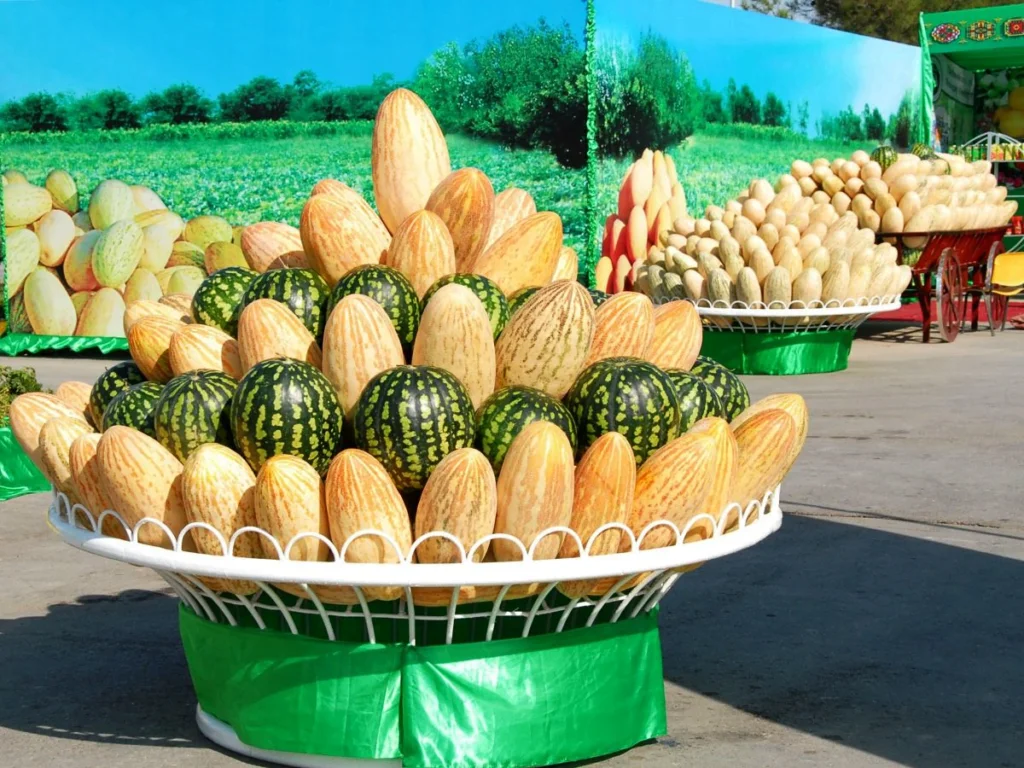
In Turkmenistan, melons are like the rock stars of the fruit world. So sweet, juicy, and famous that they have their own national holiday – Melon Day! You won’t find these babies outside Turkmenistan, so plan your visit for August if you want to join the melon party.
Turkmenistan: Where Laws are a Bit Quirky
The first president had some wild ideas. No opera, gold teeth, or spandex – seriously! And get this, he even changed the names of the days of the week to match his family members.
While some of these rules got a makeover when a new president came along, others stuck around. Case in point: black cars are out, white cars are in because, apparently, white brings good luck!
The History of Turkmenistan and the Impact it has had on the Food
Ancient Period (Before 6th Century BCE)

Nomadic Tribes: The ancient history of Turkmenistan, prior to the 6th century BCE, was characterized by the presence of nomadic tribes.
These nomads relied on a diet of easily transportable and preserved foods such as dried fruits, nuts, dairy products, and various forms of meat.
Persian Influence (6th Century BCE – 4th Century BCE)
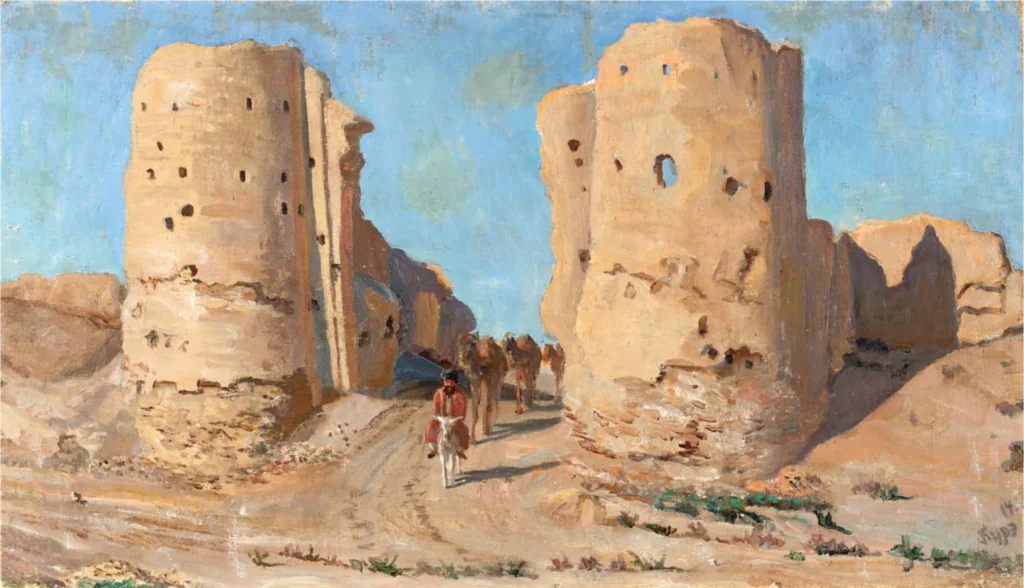
Achaemenid Empire: Turkmenistan was part of the Achaemenid Empire, experiencing Persian influence. This period introduced Persian culinary elements, including the use of saffron, dried fruits, and intricate rice dishes.
Persian-inspired dishes became part of the local cuisine during this time.
Hellenistic and Seleucid Period (4th Century BCE – 3rd Century BCE)

Greek and Seleucid Influence: Following Alexander the Great’s conquests, Turkmenistan fell under Greek and Seleucid influence.
Hellenistic culinary elements, such as the use of various spices and cooking techniques, likely influenced local cuisine.
Silk Road Trade (2nd Century BCE – 14th Century CE)
Cultural Exchange: Turkmenistan thrived as a crossroads on the Silk Road, facilitating trade and cultural exchange.
During this period, the cuisine absorbed influences from China, India, Persia, and the Middle East. Spices, fruits, and diverse culinary techniques enriched the local food culture.
Mongol Rule (13th Century CE)

In the 13th century, Turkmenistan came under Mongol rule. Mongol rulers introduced new culinary practices, emphasizing the consumption of meat and dairy products. Dishes like pilaf gained popularity during this period.
Timurid Empire (14th Century CE – 15th Century CE)
Persian Influence: Turkmenistan experienced Persian influence during the Timurid Empire. Persian culinary elements continued to impact the cuisine, with an emphasis on the use of saffron, dried fruits, and elaborate rice dishes.
Russian Imperial Period (Late 19th Century – Early 20th Century)
In the late 19th century, Turkmenistan became part of the Russian Empire. Russian influence introduced new ingredients such as potatoes and tomatoes. European cooking methods and dishes, including borscht, made their way into Turkmen cuisine.
Soviet Era (Early 20th Century – 1991)
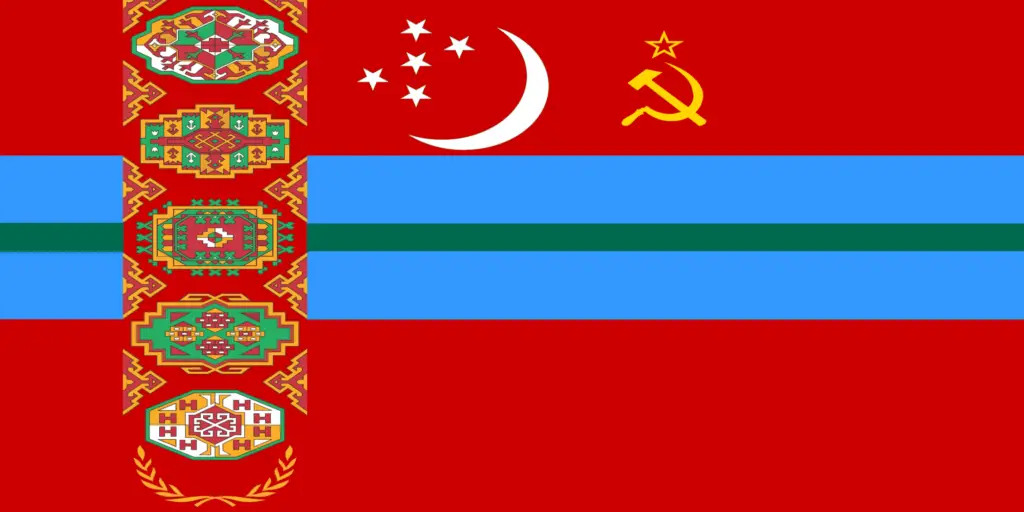
Collectivization: The Soviet era brought changes to Turkmenistan’s agriculture and food production. Collectivization efforts influenced farming practices, and the state-controlled approach affected traditional culinary practices.
Mass-produced food items became more prevalent.
Independence (1991 – Present)
Revival of Tradition: After gaining independence in 1991, Turkmenistan witnessed a renewed interest in preserving and promoting its cultural and culinary heritage. Efforts were made to revive traditional dishes, emphasizing local ingredients and cooking methods. This period marks a celebration of authentic Turkmen cuisine amidst a globalized culinary landscape.
How Turkmenistan‘s Climate and Geography has Influenced Turkmenistan‘s Cuisine
Turkmenistan’s cuisine is shaped by its dry and continental climate, as well as its desert and mountainous geography. Here are some of the ways how:
Scarcity of Water

The scarcity of water and vegetation in most parts of the country has led to the reliance on animal products, such as meat, dairy, and wool. Turkmenistan is known for its sheep breeding and camel raising, which provide meat, milk, cheese, and wool for food, clothing, and carpets
The Harsh Climate

The harsh climate and the nomadic lifestyle of many Turkmen have also influenced the preservation and preparation of food. Turkmen cuisine uses methods such as salting, drying, smoking, and pickling to preserve meat, fish, fruits, and vegetables.
Turkmen cuisine also uses simple cooking techniques, such as boiling, roasting, and baking, which require less water and fuel.
The Diversity of Climate and Geography
The diversity of climate and geography in different regions of Turkmenistan has also resulted in different culinary traditions and specialties. For example, the coastal region along the Caspian Sea has access to seafood, such as sturgeon, caviar, and herring, as well as fruits and vegetables, such as melons, grapes, and tomatoes.
The mountainous region in the south has a milder climate and more fertile soil, which allows the cultivation of wheat, barley, rice, and nuts. The desert region in the north and east has a more arid and extreme climate, which limits the availability of crops and water.
References
- Turkmenistan | People, Geography, Government, & History
- What Type Of Climate Does Turkmenistan Have? – WorldAtlas
- Turkmenistan geography, maps, climate, environment and terrain
Understanding the Essence of Turkmenistan Cuisine
Nestled between Kazakhstan, Uzbekistan, Afghanistan, and Iran, Turkmenistan is a tapestry of nomadic traditions, Silk Road influences, and ancient culinary wisdom. The nation’s gastronomic offerings are a mirror to its vibrant history and nomadic soul, revealing stories of desert landscapes, camel caravans, and centuries-old customs.
Central to Turkmen cuisine is the prominence of meats, especially lamb and mutton. The “khorovat” (grilled meat) tradition resonates with the nation’s love for open fires and communal gatherings. “Shashlik”, skewered and grilled meat cubes, epitomizes this love affair.
Grains also hold a pivotal place. “Pilav” (or plov), a hearty mix of rice, meat, and vegetables, often cooked in sheep’s fat for an authentic flavor, is not just a dish; it’s a celebration. Its preparation and consumption often denote significant occasions and festivities.
Breads, like “çörek”, are another staple. Whether it’s the sesame-sprinkled “çörek” or the deep-fried “yagly nan”, these are more than mere accompaniments. They symbolize warmth, hospitality, and the essence of home.
Turkmenistan’s deserts, though seemingly barren, yield unique flavors. The wildly grown “turkmenbashi” melons are renowned for their sweetness, often complementing the savory undertones of main dishes.
However, the soul of Turkmen cuisine lies in its rituals. The “dastarkhan”, a ceremonial spread laid on the ground, represents more than food. It’s a mosaic of traditions, from the way tea is poured—first into a cup, then back into the teapot several times—to the act of sharing meals, emphasizing the deep-rooted values of community and kinship.
In essence, Turkmenistan’s culinary traditions are a journey — an exploration of ancient customs, communal values, and the harmonious balance between the rugged landscapes and the delicacies it inspires.
Food Of Turkmenistan

Turkmenistan is renowned for its rich and diverse cuisine, reflecting its cultural heritage and geographical location. The food of Turkmenistan is a delightful fusion of flavors, blending influences from Central Asia, Persia, and Russia.
Traditional dishes such as plov, a fragrant rice pilaf cooked with meat and spices, and manty, steamed dumplings filled with lamb or beef, are staples of the Turkmen diet.
The country also boasts a vibrant street food scene, with vendors serving up samsa, savory pastries filled with minced meat and onions, and gözleme, thin flatbreads stuffed with various fillings.
Visitors to Turkmenistan can truly indulge in the unique and delicious culinary offerings of the country.
Turkmenistan Culinary Traditions
Turkmenistan, a gem in Central Asia, is a cradle of culinary heritage shaped by its nomadic past, arid landscapes, and the ebb and flow of the Silk Road. As one ventures through its cuisine, the taste and aromas unfurl tales of ancient customs, family gatherings, and the sheer brilliance of simple ingredients.
At the foundation of Turkmen meals lies “pilav,” a rich concoction of rice, tender meat, and onions, often interlaced with raisins or apricots. This dish, considered both everyday food and festive fare, echoes the nation’s heartbeats and celebrations.
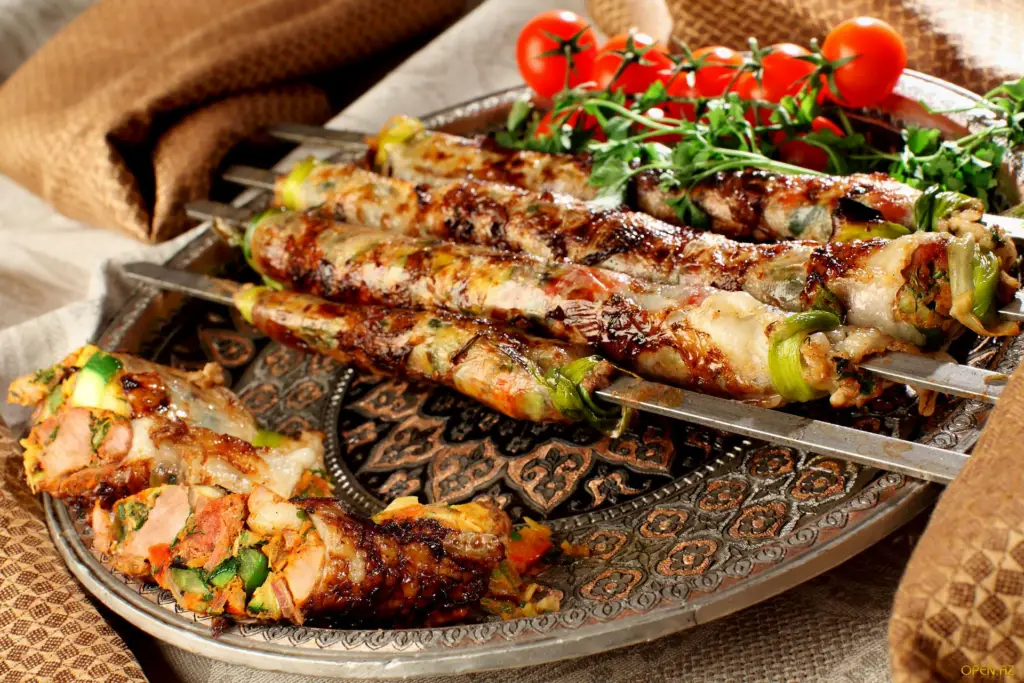
Meat, primarily mutton and lamb, is deeply revered. Dishes like “kazy,” a traditional sausage made from horse meat, and “shashlik,” skewered meat roasted over open flame, highlight the people’s mastery over meats, while “manty,” steamed dumplings filled with meat or pumpkin, encapsulate flavors of comfort and warmth.
Turkmen bread, notably “çörek”, is an emblem of hospitality. Its circular shape and decorative patterns are not only a treat to the palate but also to the eyes. It is commonly paired with “ayran,” a refreshing yogurt drink, offering a perfect blend of textures and tastes.
Fruits, especially melons, are a prized possession in Turkmen kitchens. The “turkmenbashi” melons, with their unparalleled sweetness, often serve as desserts or palate cleansers after a hearty meal.
Tea ceremonies, integral to Turkmen culture, signify relaxation and camaraderie. The ritualistic pouring and the accompaniment of dried fruits and nuts exemplify the nation’s emphasis on togetherness.
In essence, Turkmenistan’s culinary traditions are a symphony of flavors and techniques honed over millennia. They showcase not just the nation’s rich gastronomic legacy but also its values of community, generosity, and the timeless art of sharing a meal.
How Healthy is Turkmenistan Food?
The health of the Turkmenistan population and the food they eat are influenced by various factors, such as the availability of resources, the quality of health services, the prevalence of diseases, the dietary habits, and the cultural practices. Here are some of the main points:
How Healthy is the Turkmenistan Population?

According to the World Health Organization, Turkmenistan faces many health challenges, such as high rates of maternal and child mortality, infectious diseases, malnutrition, and non-communicable diseases.
The country has made some progress in improving health outcomes, such as reducing under-five mortality, increasing immunization coverage, and expanding access to HIV/AIDS treatment. However, there are still significant gaps in health equity, quality, and financing.
The Turkmenistan Cuisine is Generally Healthy
According to Nomads Unveiled, Turkmenistan food is generally considered healthy, as it is based on fresh and natural ingredients, such as meat, dairy, fruits, vegetables, and herbs.
Turkmen food also incorporates various fermented foods, such as yogurt, cheese, and pickles, which have probiotic benefits for the gut health and immune system.
Turkmenistan Cuisine has Risk Factors
However, like any cuisine, Turkmen food can also have some drawbacks, such as high salt, fat, and sugar content in some dishes, such as cured meats, pastries, and desserts. Some traditional dishes may also be high in calories and carbohydrates, such as palaw, manti, and chorek.
References
- Turkmenistan – World Health Organization
- Turkmenistan (TKM) – Demographics, Health & Infant Mortality – UNICEF DATA
- Demographics of Turkmenistan – Wikipedia
The Most Popular Turkmenistan Food
Turkmenistan boasts a diverse culinary landscape influenced by its nomadic heritage, Silk Road trade, and interactions with neighboring cultures. Some of the most popular and beloved Turkmen dishes include:
1. Palaw (Plov or Pilaf)
- Description: A traditional rice dish cooked with lamb or beef, carrots, onions, and various spices. It is a hearty and flavorful dish often served during special occasions and celebrations.
2. Shashlyk (Shish Kebabs)
- Description: Skewered and grilled meat, usually lamb or beef, marinated in a mixture of spices and served with flatbread. Shashlyk is a popular street food and a favorite at social gatherings.
3. Manty
- Description: Dumplings filled with minced meat (often lamb or beef), onions, and spices. They are typically steamed and served with yogurt or a garlic sauce. Manty are a staple of Turkmen cuisine.
4. Gutap
- Description: A savory pastry filled with minced meat, onions, and various herbs. Gutap can be baked or fried and is a common snack or appetizer in Turkmen households.
5. Ezme Salad
- Description: A spicy tomato and pepper salad with herbs and onions. It serves as a refreshing side dish or condiment, adding a burst of flavors to meals.
6. Chorba
- Description: A hearty soup featuring meat (often lamb or beef), vegetables, and legumes. Chorba is seasoned with a blend of spices, making it a comforting and nutritious dish.
7. Yarma
- Description: Whole wheat or barley grains cooked with meat, onions, and spices. Yarma is a wholesome and nutritious dish that reflects the nomadic roots of Turkmenistan.
8. Yaprak Borek
- Description: Thin layers of dough filled with minced meat, herbs, and spices, then rolled into a spiral. Yaprak Borek is baked to a golden brown and is a popular item during festive occasions.
9. Chak-Chak
- Description: Deep-fried dough balls coated in honey or syrup, sometimes with the addition of nuts. Chak-Chak is a sweet treat enjoyed during holidays and celebrations.
10. Samsa
- Description: Triangular pastries filled with minced meat, onions, and spices. Samsa is baked until golden and is a popular snack or appetizer in Turkmen cuisine.
11. Ayran
- Description: A traditional yogurt-based drink, often mixed with water and seasoned with a pinch of salt. Ayran is a refreshing beverage enjoyed alongside meals, especially during warm weather.
These dishes showcase the rich flavors, unique combinations of ingredients, and cultural influences that contribute to the diverse and delicious cuisine of Turkmenistan.
Great Turkmenistan Food Recipes to try at home
It is a delicious blend of the country’s nomadic past and agricultural influences. Central to its culinary identity are hearty meats, fresh vegetables, and an array of grains, accentuated with aromatic herbs and spices. Each dish tells a story of its nomadic origins, familial gatherings, and celebrations.
Turkmenistan Food – Sesame-Sprinkled “çörek”

History and Background of Sesame-Sprinkled “çörek”
Sesame-Sprinkled “çörek” is a delightful Turkmen pastry with a rich history reflecting the nation’s nomadic heritage and its position on the Silk Road. Originating from the Turkic culinary traditions, çörek has evolved over centuries to become a beloved treat in Turkmenistan.
This pastry is often enjoyed during festive occasions, celebrations, and family gatherings, showcasing the significance of communal bonds and the joy of shared meals in Turkmen culture.
Ingredients for Sesame-Sprinkled “çörek”
Main Ingredients:
- 3 cups all-purpose flour
- 1 cup warm milk
- 1/2 cup vegetable oil
- 1/4 cup sugar
- 1 packet active dry yeast
- 1 egg (for egg wash)
- Sesame seeds for sprinkling
Optional Fillings:
- 1/2 cup chopped nuts (walnuts, almonds, or hazelnuts)
- 1/4 cup raisins
- 1 teaspoon ground cinnamon
Recipe for Sesame-Sprinkled “çörek”
Prepare the Dough
Ingredients:
- 3 cups all-purpose flour
- 1 cup warm milk
- 1/4 cup sugar
- 1 packet active dry yeast
- In a bowl, dissolve the sugar in warm milk and add the active dry yeast. Allow it to sit for 5-10 minutes until frothy.
- In a large mixing bowl, combine the flour and the yeast mixture, kneading until a soft dough forms.
- Cover the bowl with a kitchen towel and let the dough rise in a warm place for 1-2 hours or until it doubles in size.
Shape and Fill the Dough
Ingredients:
- Prepared dough
- 1/2 cup vegetable oil
- Optional: 1/2 cup chopped nuts, 1/4 cup raisins, 1 teaspoon ground cinnamon
- Preheat the oven to 350°F (180°C).
- Divide the dough into two portions. Roll out one portion into a rectangle on a floured surface.
- Brush the rolled-out dough with vegetable oil and sprinkle with optional fillings like chopped nuts, raisins, and ground cinnamon.
- Roll the dough tightly into a log and repeat the process with the second portion.
Shape the Pastry
Ingredients:
- Rolled and filled dough logs
- Take each rolled dough log and shape it into a circular coil or a twisted wreath on a baking sheet lined with parchment paper.
Egg Wash and Sesame Sprinkling
Ingredients:
- 1 egg (for egg wash)
- Sesame seeds for sprinkling
- Beat the egg and brush it over the shaped dough for a golden finish.
- Sprinkle sesame seeds generously over the egg-washed dough.
Bake and Enjoy
- Bake in the preheated oven for 25-30 minutes or until the çörek turns golden brown.
- Allow it to cool before slicing and serving.
Serving Information
This recipe makes approximately 8 servings.
Estimated Cooking Time
- Preparation: 20 minutes
- Rising: 1-2 hours
- Baking: 25-30 minutes
Nutritional Information (Approximate)
Calories per serving: 250 kcal (calories may vary based on optional fillings and serving size)
Turkmenistan Food – Gutap

History and Background of Gutap
Gutap is a traditional Turkmen pastry deeply rooted in the cultural and culinary heritage of Turkmenistan. Originating from Turkic traditions, Gutap holds historical significance as a dish that reflects the nomadic lifestyle of the Turkmen people.
This savory pastry is commonly prepared during special occasions, family gatherings, and festive celebrations, serving as a symbol of community and shared joy in Turkmen cuisine.
Ingredients for Gutap
For the Dough:
- 3 cups all-purpose flour
- 1 cup warm water
- 1/4 cup vegetable oil
- 1 teaspoon salt
For the Filling:
- 1 cup finely chopped greens (spinach, cilantro, or a mix)
- 1 cup ground lamb or beef
- 1 onion, finely chopped
- Salt and pepper to taste
- Vegetable oil for frying
Recipe for Gutap
Prepare the Dough
Ingredients:
- 3 cups all-purpose flour
- 1 cup warm water
- 1/4 cup vegetable oil
- 1 teaspoon salt
- In a large bowl, combine the flour and salt.
- Gradually add warm water and vegetable oil, kneading the mixture into a smooth dough.
- Cover the dough with a kitchen towel and let it rest for 30 minutes.
Prepare the Filling
Ingredients:
- 1 cup finely chopped greens (spinach, cilantro, or a mix)
- 1 cup ground lamb or beef
- 1 onion, finely chopped
- Salt and pepper to taste
- Vegetable oil for frying
- In a separate bowl, mix the finely chopped greens, ground meat, chopped onion, salt, and pepper to create the filling.
Shape and Fill the Pastry
Ingredients:
- Prepared dough
- Prepared filling
- Vegetable oil for frying
- Divide the rested dough into small balls and roll each ball into a thin circle on a floured surface.
- Place a spoonful of the filling in the center of each dough circle.
- Fold the dough over the filling to create a half-moon shape and press the edges to seal.
Fry the Gutap
Ingredients:
- Filled gutap
- Vegetable oil for frying
- In a pan, heat vegetable oil over medium heat.
- Carefully fry each gutap until golden brown on both sides.
- Place the fried gutap on paper towels to absorb excess oil.
Serving Information
This recipe makes approximately 12 gutaps.
Estimated Cooking Time
- Preparation: 40 minutes
- Resting: 30 minutes
- Cooking: 20 minutes
Nutritional Information (Approximate)
Calories per serving: 180 kcal (calories may vary based on specific ingredients and portion size)
Turkmenistan Food – Ezme Salad

History and Background of Ezme Salad
Ezme Salad is a vibrant and flavorful dish originating from Turkmenistan, reflecting the region’s rich culinary traditions. Known for its fresh and zesty taste, Ezme Salad has its roots in Turkic cuisine, emphasizing the use of locally sourced ingredients.
This salad holds cultural significance as a refreshing accompaniment to various Turkmen meals and is often enjoyed during special occasions, adding a burst of colors and flavors to the table.
Ingredients for Ezme Salad
Main Ingredients:
- 4 medium-sized tomatoes, diced
- 2 cucumbers, finely chopped
- 1 red onion, finely diced
- 1 green bell pepper, finely chopped
- 1/2 cup fresh parsley, chopped
- 1/4 cup fresh mint leaves, chopped
Dressing:
- 3 tablespoons olive oil
- 2 tablespoons pomegranate molasses
- Juice of 1 lemon
- Salt and pepper to taste
Recipe for Ezme Salad
Prepare the Vegetables
Ingredients:
- 4 medium-sized tomatoes, diced
- 2 cucumbers, finely chopped
- 1 red onion, finely diced
- 1 green bell pepper, finely chopped
- 1/2 cup fresh parsley, chopped
- 1/4 cup fresh mint leaves, chopped
- In a large mixing bowl, combine the diced tomatoes, chopped cucumbers, finely diced red onion, chopped green bell pepper, fresh parsley, and mint leaves.
Prepare the Dressing
Ingredients:
- 3 tablespoons olive oil
- 2 tablespoons pomegranate molasses
- Juice of 1 lemon
- Salt and pepper to taste
- In a small bowl, whisk together olive oil, pomegranate molasses, lemon juice, salt, and pepper to create the dressing.
Mix and Chill
- Pour the dressing over the prepared vegetables in the large mixing bowl.
- Gently toss the ingredients until well coated with the dressing.
- Cover the bowl and let the Ezme Salad chill in the refrigerator for at least 30 minutes to allow the flavors to meld.
Serve and Enjoy
- Once chilled, give the salad a final toss.
- Serve Ezme Salad as a refreshing side dish alongside your favorite Turkmen main courses.
Serving Information
This recipe makes approximately 4 servings.
Estimated Preparation Time
- Preparation: 15 minutes
- Chilling: 30 minutes
Nutritional Information (Approximate)
Calories per serving: 120 kcal (calories may vary based on specific ingredients and portion size)
Turkmenistan Food – Yarma

History and Background of Yarma
Yarma is a traditional Turkmen dish with a deep historical connection to the nomadic roots of the Turkmen people. Originating from the Turkic culinary traditions, Yarma showcases the resourcefulness of Turkmenistan’s inhabitants, utilizing whole grains like wheat or barley.
This nutritious and hearty dish, often cooked with meat and spices, reflects the nomadic lifestyle and the need for sustaining meals in the harsh Turkmen environment.
Ingredients for Yarma
Main Ingredients:
- 1 cup whole wheat or barley grains
- 1/2 pound lamb or beef, cubed
- 1 large onion, finely chopped
- 2 tomatoes, diced
- 2 tablespoons vegetable oil
- 1 teaspoon ground cumin
- Salt and pepper to taste
Optional Garnish:
- Fresh cilantro or parsley, chopped
Recipe for Yarma
Prepare the Grains
Ingredients:
- 1 cup whole wheat or barley grains
- Rinse the whole wheat or barley grains under cold water.
- In a pot, combine the grains with enough water to cover and bring to a boil.
- Reduce the heat and simmer until the grains are tender but still have a slight bite. Drain any excess water.
Cook the Meat
Ingredients:
- 1/2 pound lamb or beef, cubed
- 2 tablespoons vegetable oil
- 1 large onion, finely chopped
- In a separate pot, heat vegetable oil and sauté the chopped onion until golden.
- Add the cubed meat and cook until browned.
Combine Grains and Meat
Ingredients:
- Cooked grains
- Cooked meat and onions
- 2 tomatoes, diced
- 1 teaspoon ground cumin
- Salt and pepper to taste
- Add the cooked grains to the pot with the browned meat and onions.
- Stir in diced tomatoes, ground cumin, salt, and pepper.
- Simmer the mixture over low heat, allowing the flavors to meld, for approximately 15-20 minutes.
Garnish and Serve
Ingredients:
- Optional: Fresh cilantro or parsley, chopped
- Garnish the Yarma with chopped fresh cilantro or parsley.
- Serve Yarma hot as a wholesome main dish.
Serving Information
This recipe makes approximately 4 servings.
Estimated Cooking Time
- Preparation: 15 minutes
- Cooking: 45 minutes
Nutritional Information (Approximate)
Calories per serving: 300 kcal (calories may vary based on specific ingredients and portion size)
Turkmenistan Food – Sigara Borek

History and Background of Sigara Borek
Sigara Borek, a popular dish in Turkmenistan, has a rich history intertwined with the culinary traditions of the region. Originating from the Turkic heritage, this savory pastry reflects the nomadic lifestyle of the Turkmen people.
The name “Sigara Borek” translates to “cigarette borek” in Turkish, highlighting the dish’s slim, cylindrical shape resembling a cigarette. This delightful treat, often enjoyed as a snack or appetizer, showcases the fusion of flavors and textures that define Turkmen cuisine.
Ingredients for Sigara Borek
Main Ingredients:
- 1 package phyllo dough, thawed
- 1/2 pound feta cheese, crumbled
- 1/2 cup parsley, finely chopped
- 1 egg (for egg wash)
- Vegetable oil for frying
Optional Ingredients:
- Ground meat (lamb or beef) for a meat filling
- Spinach and onions for a vegetarian filling
Recipe for Sigara Borek
Prepare the Filling
Ingredients:
- 1/2 pound feta cheese, crumbled
- 1/2 cup parsley, finely chopped
- Optional: Ground meat or spinach and onions for alternative fillings
- In a bowl, combine the crumbled feta cheese and finely chopped parsley.
- If desired, prepare an alternative filling by sautéing ground meat or spinach and onions until cooked.
Assemble the Sigara Borek
Ingredients:
- 1 package phyllo dough, thawed
- Prepared filling
- 1 egg (for egg wash)
- Lay out a sheet of phyllo dough and place a spoonful of the filling at one end.
- Roll the phyllo dough tightly over the filling to form a slim, cigar-like shape.
- Beat an egg and brush it over the rolled Sigara Borek to seal the edges.
Fry or Bake
Ingredients:
- Vegetable oil for frying (or oven for baking)
- Heat vegetable oil in a pan for frying or preheat the oven to 375°F (190°C) for baking.
- If frying, carefully fry each Sigara Borek until golden brown on all sides. If baking, place them on a baking sheet and bake until golden.
Serve and Enjoy
- Once cooked, place the Sigara Borek on paper towels to absorb excess oil.
- Serve hot as a delightful snack or appetizer.
Serving Information
This recipe makes approximately 20 Sigara Borek.
Estimated Cooking Time
- Preparation: 20 minutes
- Cooking (frying or baking): 15 minutes
Nutritional Information (Approximate)
Calories per serving: 80 kcal (calories may vary based on specific ingredients and portion size)
Turkmenistan Food – Samsa

History and Background of Samsa
Samsa, a beloved dish in Turkmenistan, has a long history rooted in Central Asian culinary traditions. Originating from the Turkic nomadic heritage, Samsa has become a staple in Turkmen cuisine.
This savory pastry is renowned for its flaky layers and flavorful fillings, typically consisting of minced meat, onions, and spices.
Samsa holds cultural significance, often enjoyed during festive occasions and family gatherings, showcasing the warmth and hospitality of Turkmen traditions.
Ingredients for Samsa
For the Dough:
- 3 cups all-purpose flour
- 1 cup warm water
- 1/4 cup vegetable oil
- 1 teaspoon salt
For the Filling:
- 1 pound ground lamb or beef
- 1 large onion, finely chopped
- 2 teaspoons ground cumin
- Salt and pepper to taste
Optional Ingredients:
- Chopped fresh herbs (parsley or cilantro) for garnish
Recipe for Samsa
Prepare the Dough
Ingredients:
- 3 cups all-purpose flour
- 1 cup warm water
- 1/4 cup vegetable oil
- 1 teaspoon salt
- In a large bowl, combine the flour and salt.
- Gradually add warm water and vegetable oil, kneading the mixture into a smooth dough.
- Cover the dough with a kitchen towel and let it rest for 30 minutes.
Prepare the Filling
Ingredients:
- 1 pound ground lamb or beef
- 1 large onion, finely chopped
- 2 teaspoons ground cumin
- Salt and pepper to taste
- In a mixing bowl, combine the ground meat, finely chopped onion, ground cumin, salt, and pepper.
Shape and Fill the Samsa
Ingredients:
- Prepared dough
- Prepared filling
- Optional: Chopped fresh herbs for garnish
- Preheat the oven to 375°F (190°C).
- Divide the rested dough into equal portions and roll each portion into a thin oval shape.
- Place a portion of the filling on one side of the oval-shaped dough and fold the other side over to create a triangular shape. Seal the edges.
Bake the Samsa
- Place the shaped Samsa on a baking sheet and bake in the preheated oven for 20-25 minutes or until golden brown.
Garnish and Serve
Ingredients:
- Baked Samsa
- Optional: Chopped fresh herbs
- Once baked, garnish the Samsa with chopped fresh herbs if desired.
- Serve the warm Samsa as a delightful appetizer or snack.
Serving Information
This recipe makes approximately 12 Samsa.
Estimated Cooking Time
- Preparation: 30 minutes
- Resting: 30 minutes
- Baking: 20-25 minutes
Nutritional Information (Approximate)
Calories per serving: 180 kcal (calories may vary based on specific ingredients and portion size)
Turkmenistan Food – Halva

History and Background of Halva
Halva, a beloved sweet treat in Turkmenistan, has a history deeply rooted in Central Asian and Middle Eastern culinary traditions. This confection has been enjoyed for centuries and holds cultural significance, often being shared during special occasions and celebrations. Halva typically features ingredients like sugar, nuts, and sometimes flour or semolina.
The preparation methods and variations vary across regions, showcasing the diversity of Turkmen cuisine. With its delightful sweetness and rich texture, Halva continues to be a symbol of hospitality and joy in Turkmen households.
Ingredients for Halva
- 1 cup unsalted butter
- 2 cups semolina
- 1 cup granulated sugar
- 2 cups water
- 1 cup milk
- 1 cup chopped nuts (almonds, pistachios, or walnuts)
- 1 teaspoon vanilla extract
- Ground cinnamon for garnish (optional)
Recipe for Halva
Prepare Ingredients
Ingredients:
- 1 cup unsalted butter
- 2 cups semolina
- 1 cup granulated sugar
- 2 cups water
- 1 cup milk
- 1 cup chopped nuts (almonds, pistachios, or walnuts)
- 1 teaspoon vanilla extract
- Measure 1 cup of unsalted butter.
- In a separate bowl, combine 2 cups of semolina and 1 cup of granulated sugar.
- In a saucepan, mix 2 cups of water and 1 cup of milk.
- Chop 1 cup of nuts (almonds, pistachios, or walnuts).
- Prepare 1 teaspoon of vanilla extract.
Cook Semolina Mixture
Ingredients:
- Prepared unsalted butter
- Prepared semolina and sugar mixture
- In a large skillet, melt the unsalted butter over medium heat.
- Add the semolina and sugar mixture to the melted butter.
- Cook, stirring continuously, until the semolina turns golden brown.
Add Liquid Mixture
Ingredients:
- Prepared water and milk mixture
- Slowly pour the water and milk mixture into the skillet, stirring constantly to avoid lumps.
Add Nuts and Vanilla
Ingredients:
- Chopped nuts
- Vanilla extract
- Mix in the chopped nuts and vanilla extract, ensuring even distribution.
Cook Until Thickened
- Continue cooking and stirring until the mixture thickens and pulls away from the sides of the skillet.
Serve and Garnish
Ingredients:
- Ground cinnamon (optional)
- Once thickened, remove from heat and transfer the Halva to a serving dish.
- Optionally, sprinkle ground cinnamon on top for garnish.
- Serve warm or at room temperature.
Serving Information
This recipe makes approximately 8 servings.
Estimated Cooking Time
- Preparation: 15 minutes
- Cooking: 30 minutes
Nutritional Information (Approximate)
Calories per serving: 400 kcal (calories may vary based on specific ingredients and portion size)
Turkmenistan Food – Spinach Manti (Spinach Dumplings)

History and Background of Spinach Manti (Spinach Dumplings)
Spinach Manti, a delightful dish in Turkmenistan, reflects the influence of Central Asian cuisine on the region. Manti, a type of dumpling, has roots in Turkish and Central Asian cultures and has become a beloved dish in Turkmen households.
The dish typically consists of thin dough filled with a mixture of spinach and various seasonings. Manti holds cultural significance and is often prepared during festive occasions, showcasing the importance of communal dining and traditional flavors in Turkmen cuisine.
Ingredients for Spinach Manti
- Dough:
- 2 cups all-purpose flour
- 1/2 cup water
- 1 egg
- 1/2 teaspoon salt
- Filling:
- 2 cups fresh spinach, chopped
- 1 cup feta cheese, crumbled
- 1 small onion, finely chopped
- 2 tablespoons olive oil
- Salt and pepper to taste
- Serving:
- Yogurt
- Mint leaves for garnish (optional)
Recipe for Spinach Manti
Prepare Dough
Ingredients:
- 2 cups all-purpose flour
- 1/2 cup water
- 1 egg
- 1/2 teaspoon salt
- In a large bowl, combine the all-purpose flour and salt.
- Make a well in the center and add the egg and water.
- Mix the ingredients until a dough forms, then knead the dough until smooth.
- Cover the dough and let it rest for at least 30 minutes.
Prepare Filling
Ingredients:
- 2 cups fresh spinach, chopped
- 1 cup feta cheese, crumbled
- 1 small onion, finely chopped
- 2 tablespoons olive oil
- Salt and pepper to taste
- In a skillet, heat olive oil over medium heat.
- Add chopped onion and sauté until translucent.
- Add chopped spinach to the skillet and cook until wilted.
- Remove from heat, let it cool, then mix in crumbled feta cheese.
- Season the filling with salt and pepper to taste.
Assemble Spinach Manti
Ingredients:
- Prepared dough
- Prepared filling
- Roll out the dough thinly on a floured surface.
- Cut the dough into small squares.
- Place a small amount of the spinach and feta filling in the center of each square.
- Fold the squares into a triangular shape, sealing the edges.
Cook Spinach Manti
- Bring a large pot of salted water to a boil.
- Carefully add the spinach Manti to the boiling water and cook until they float to the surface (about 5-7 minutes).
- Remove Manti with a slotted spoon and place them on a serving dish.
Serve and Garnish
Ingredients:
- Yogurt
- Mint leaves for garnish (optional)
- Serve the spinach Manti with a side of yogurt.
- Garnish with mint leaves if desired.
Serving Information
This recipe makes approximately 4 servings.
Estimated Cooking Time
- Preparation: 45 minutes
- Cooking: 5-7 minutes per batch
Nutritional Information (Approximate)
Calories per serving: 350 kcal (calories may vary based on specific ingredients and portion size)
Turkmenistan Food- Mushroom Beshbarmak (Noodle Stew with Vegetables)

History and Background of Mushroom Beshbarmak (Noodle Stew with Vegetables)
Mushroom Beshbarmak is a flavorful dish originating from Turkmenistan, deeply rooted in Central Asian culinary traditions. Beshbarmak, meaning “five fingers” in Turkic languages, symbolizes the communal nature of the meal where people traditionally eat with their hands.
This variation, featuring mushrooms and vegetables, showcases the adaptability of Beshbarmak to different tastes while maintaining its essence as a hearty, communal dish in Turkmen cuisine.
Ingredients for Mushroom Beshbarmak
- Noodles:
- 2 cups all-purpose flour
- 1/2 cup water
- 1 egg
- 1/2 teaspoon salt
- Stew:
- 2 cups mushrooms, sliced
- 1 large onion, finely chopped
- 2 carrots, sliced
- 2 potatoes, diced
- 1 cup green beans, chopped
- 3 tablespoons vegetable oil
- Salt and pepper to taste
- Serving:
- Fresh parsley for garnish
- Sour cream
Recipe for Mushroom Beshbarmak
Prepare Noodles
Ingredients:
- 2 cups all-purpose flour
- 1/2 cup water
- 1 egg
- 1/2 teaspoon salt
- In a bowl, combine the all-purpose flour and salt.
- Create a well in the center and add the egg and water.
- Mix the ingredients until a dough forms, then knead until smooth.
- Cover the dough and let it rest for at least 30 minutes.
- Roll out the dough and cut it into thin strips to make noodles.
Prepare Stew
Ingredients:
- 2 cups mushrooms, sliced
- 1 large onion, finely chopped
- 2 carrots, sliced
- 2 potatoes, diced
- 1 cup green beans, chopped
- 3 tablespoons vegetable oil
- Salt and pepper to taste
- In a large pot, heat vegetable oil over medium heat.
- Add chopped onions and sauté until translucent.
- Add sliced mushrooms and cook until they release their juices.
- Add sliced carrots, diced potatoes, and chopped green beans to the pot.
- Season with salt and pepper, and cook until vegetables are tender.
Cook Noodles and Assemble
Ingredients:
- Prepared noodles
- Prepared stew
- Boil the prepared noodles in salted water until they float to the surface (about 3-5 minutes).
- Drain the noodles and place them on a serving platter.
- Spoon the mushroom and vegetable stew over the noodles.
Serve and Garnish
Ingredients
- Fresh parsley for garnish
- Sour cream
- Garnish the Mushroom Beshbarmak with fresh parsley.
- Serve hot with a side of sour cream.
Serving Information
This recipe makes approximately 4 servings.
Estimated Cooking Time
- Preparation: 45 minutes
- Cooking: 30 minutes
Nutritional Information (Approximate)
Calories per serving: 400 kcal (calories may vary based on specific ingredients and portion size)
Turkmenistan Food – Unash (Vegetable Stew)

History and Background of Unash (Vegetable Stew)
Unash, a beloved Turkmenistan dish, is a vegetable stew deeply embedded in the rich culinary traditions of Central Asia. Originating from Turkmen households, Unash represents a wholesome and nutritious meal that showcases the region’s agricultural abundance.
With a medley of vegetables and aromatic spices, Unash reflects the Turkmen emphasis on communal dining and the celebration of local produce.
Ingredients for Unash (Vegetable Stew)
- 2 large potatoes, diced
- 2 carrots, sliced
- 1 large onion, finely chopped
- 1 cup cabbage, shredded
- 1 cup bell peppers, diced
- 1 cup tomatoes, chopped
- 1 cup green beans, chopped
- 3 tablespoons vegetable oil
- 2 cloves garlic, minced
- 1 teaspoon ground cumin
- Salt and pepper to taste
- 4 cups vegetable broth
Recipe for Unash (Vegetable Stew)
Prepare Vegetables
Ingredients:
- 2 large potatoes, diced
- 2 carrots, sliced
- 1 large onion, finely chopped
- 1 cup cabbage, shredded
- 1 cup bell peppers, diced
- 1 cup tomatoes, chopped
- 1 cup green beans, chopped
- In a large pot, heat vegetable oil over medium heat.
- Add chopped onions and sauté until translucent.
- Add minced garlic and sauté for an additional minute.
- Add diced potatoes, sliced carrots, shredded cabbage, diced bell peppers, chopped tomatoes, and chopped green beans to the pot.
Season and Cook
Ingredients:
- 3 tablespoons vegetable oil
- 2 cloves garlic, minced
- 1 teaspoon ground cumin
- Salt and pepper to taste
- 4 cups vegetable broth
- Season the vegetables with ground cumin, salt, and pepper.
- Pour in the vegetable broth to cover the vegetables.
- Bring the stew to a boil, then reduce heat to simmer.
- Cover the pot and let it cook for about 20-25 minutes or until the vegetables are tender.
Serve
- Once cooked, ladle the Unash into bowls.
- Serve hot, optionally garnished with fresh herbs or a dollop of yogurt.
Serving Information
This recipe makes approximately 4 servings.
Estimated Cooking Time
- Preparation: 15 minutes
- Cooking: 25 minutes
Nutritional Information (Approximate)
Calories per serving: 200 kcal (calories may vary based on specific ingredients and portion size)
Turkmenistan Food – Dograma (Thin Crepes)

History and Background of Dograma (Thin Crepes)
Dograma, a delightful treat hailing from Turkmenistan, holds a special place in Central Asian cuisine. These thin crepes showcase the culinary diversity of the region, providing a versatile base for both sweet and savory fillings.
Traditionally enjoyed during festive occasions and family gatherings, Dograma reflects the Turkmen appreciation for simple yet delicious dishes that bring people together.
Ingredients for Dograma (Thin Crepes)
- 2 cups all-purpose flour
- 2 eggs
- 2 cups milk
- 1/2 teaspoon salt
- 2 tablespoons vegetable oil
- Additional oil for frying
Recipe for Dograma (Thin Crepes)
Prepare the Batter
Ingredients:
- 2 cups all-purpose flour
- 2 eggs
- 2 cups milk
- 1/2 teaspoon salt
- In a mixing bowl, combine the all-purpose flour and salt.
- In a separate bowl, whisk together the eggs and milk.
- Gradually pour the wet ingredients into the dry ingredients, stirring continuously to form a smooth batter.
- Add vegetable oil to the batter and mix well.
Cook the Crepes
Ingredients:
- Prepared batter
- Additional oil for frying
- Heat a non-stick skillet or crepe pan over medium heat.
- Lightly grease the pan with oil.
- Pour a small ladleful of batter into the center of the pan, swirling to spread it thinly.
- Cook the crepe for 1-2 minutes until the edges begin to lift, then flip and cook the other side.
- Repeat until all the batter is used, stacking the crepes on a plate.
Serve
- Serve the Dograma warm with your choice of sweet or savory fillings.
Serving Information
This recipe makes approximately 10-12 crepes.
Estimated Cooking Time
- Preparation: 10 minutes
- Cooking: 20 minutes
Nutritional Information (Approximate)
Calories per crepe: 80 kcal (calories may vary based on specific ingredients and portion size)
Turkmenistan Food – Palaw or Pilaf (Rice Dish)

History and Background of Palaw or Pilaf (Rice Dish)
Palaw, also known as Pilaf, is a cherished dish with deep roots in Turkmenistan’s culinary heritage. This flavorful rice dish is a staple in Central Asian cuisine and reflects the region’s nomadic traditions.
Often prepared for festive occasions and family gatherings, Palaw showcases the Turkmen love for aromatic spices and the skillful preparation of rice, making it a delicious and culturally significant part of their culinary repertoire.
Ingredients for Palaw or Pilaf (Rice Dish)
- 2 cups basmati rice
- 1 lb lamb or beef, cubed
- 1 large onion, finely chopped
- 2 carrots, julienned
- 1/2 cup vegetable oil
- 1 teaspoon cumin
- 1 teaspoon coriander
- Salt and pepper to taste
- 4 cups water or broth
Recipe for Palaw or Pilaf (Rice Dish)
Prepare Ingredients
Ingredients:
- 2 cups basmati rice
- 1 lb lamb or beef, cubed
- 1 large onion, finely chopped
- 2 carrots, julienned
- Rinse the basmati rice under cold water until the water runs clear. Set aside.
- In a large pot, heat vegetable oil over medium heat.
- Add chopped onions and sauté until golden brown.
- Add cubed lamb or beef to the pot and brown on all sides.
- Add julienned carrots to the pot and sauté for an additional 2-3 minutes.
Season and Cook
Ingredients:
- 1 teaspoon cumin
- 1 teaspoon coriander
- Salt and pepper to taste
- 4 cups water or broth
- Season the mixture with cumin, coriander, salt, and pepper.
- Pour in water or broth to cover the ingredients.
- Bring the mixture to a boil, then reduce heat to low, cover, and simmer for 20-25 minutes or until the rice is cooked and the liquid is absorbed.
Serve
- Fluff the rice with a fork and serve the Palaw hot.
Serving Information
This recipe makes approximately 4-6 servings.
Estimated Cooking Time
- Preparation: 15 minutes
- Cooking: 30 minutes
Nutritional Information (Approximate)
Calories per serving: 400 kcal (calories may vary based on specific ingredients and portion size)
Turkmenistan Drink – Sherbet (Fruit Drinks)

History and Background of Sherbet (Fruit Drinks)
Sherbet, a refreshing beverage popular in Turkmenistan, has a history deeply intertwined with the region’s culinary traditions. Originating from the Middle East, sherbet has been enjoyed for centuries as a cooling and flavorful drink, especially during hot weather.
The term “sherbet” refers to various fruit drinks made with a combination of fruit juices, water, sugar, and sometimes herbs or spices.
In Turkmenistan, sherbet is often served as a welcoming gesture to guests and is an integral part of celebrations, embodying the warmth and hospitality of Turkmen culture.
Ingredients for Sherbet
- 2 cups mixed fruit juices (orange, pomegranate, or any preferred fruits)
- 1 cup cold water
- 1/2 cup sugar
- Fresh mint leaves for garnish (optional)
- Ice cubes for serving
Recipe for Sherbet
Prepare Ingredients
Ingredients:
- 2 cups mixed fruit juices (orange, pomegranate, or any preferred fruits)
- 1 cup cold water
- 1/2 cup sugar
- Fresh mint leaves for garnish (optional)
- Ice cubes for serving
- Choose and mix 2 cups of fruit juices, such as orange or pomegranate, or a combination of preferred fruits.
- Measure 1 cup of cold water.
- Prepare 1/2 cup of sugar.
- Optionally, gather fresh mint leaves for garnish.
- Have ice cubes ready for serving.
Mix Fruit Juices and Sugar
Ingredients:
- Mixed fruit juices
- Sugar
- In a large pitcher, combine the mixed fruit juices with the sugar.
- Stir well to ensure the sugar dissolves into the fruit juices.
Add Cold Water
Ingredients:
- Mixed fruit juices with sugar
- Cold water
- Pour the cold water into the pitcher with the mixed fruit juices and sugar.
- Stir to combine all the ingredients thoroughly.
Chill and Garnish
Ingredients:
- Prepared sherbet
- Fresh mint leaves (optional)
- Place the pitcher in the refrigerator and let the sherbet chill for at least 1 hour.
- Before serving, garnish with fresh mint leaves if desired.
Serve Over Ice
Ingredients:
- Chilled sherbet
- Ice cubes
- Fill glasses with ice cubes.
- Pour the chilled sherbet over the ice and serve immediately.
Serving Information
This recipe makes approximately 4 servings.
Estimated Preparation Time
- Preparation: 10 minutes
- Chilling: 1 hour (optional)
Nutritional Information (Approximate)
Calories per serving: 120 kcal (calories may vary based on specific ingredients and portion size)
Turkmenistan Drink – Ayran

History and Background of Ayran
Ayran, a traditional Turkmen drink, has deep roots in Central Asian and Middle Eastern cultures. Originating from the nomadic heritage of the Turkmen people, Ayran has been a refreshing and nutritious beverage for centuries.
This simple yet flavorful drink is made with a combination of yogurt, water, and a pinch of salt, reflecting the resourcefulness and practicality of Turkmenistan’s culinary traditions.
Ayran is not only a popular thirst quencher but also serves as a symbol of hospitality in Turkmen households.
Ingredients for Ayran
- 1 cup plain yogurt
- 1 cup cold water
- 1/4 teaspoon salt
- Ice cubes (optional)
- Fresh mint leaves for garnish (optional)
Recipe for Ayran
Gather Ingredients
Ingredients:
- 1 cup plain yogurt
- 1 cup cold water
- 1/4 teaspoon salt
- Measure 1 cup of plain yogurt.
- Prepare 1 cup of cold water.
Mix Yogurt and Water
Ingredients:
- 1 cup plain yogurt
- 1 cup cold water
- In a mixing bowl, combine the plain yogurt and cold water.
Add Salt
Ingredients:
- 1/4 teaspoon salt
- Add 1/4 teaspoon of salt to the yogurt-water mixture.
Mix Thoroughly
- Use a whisk or spoon to thoroughly mix the ingredients until the salt is dissolved and the yogurt is well incorporated.
Chill and Serve
Ingredients:
- Prepared Ayran
- Ice cubes (optional)
- Fresh mint leaves for garnish (optional)
- Chill the Ayran in the refrigerator for at least 30 minutes.
- If desired, add ice cubes to the Ayran for an extra refreshing touch.
- Garnish with fresh mint leaves if you like.
- Stir before serving and enjoy the cool, tangy goodness of Ayran.
Serving Information
This recipe makes approximately 2 servings.
Estimated Preparation Time
- Preparation: 5 minutes
- Chilling: 30 minutes (optional)
Nutritional Information (Approximate)
Calories per serving: 60 kcal (calories may vary based on specific ingredients and portion size)
Turkmenistan Cuisine – Shekerbura

Shekerbura, though popular in various parts of Central Asia and the Caucasus region, holds a special place in Turkmenistan’s culinary landscape. The name ‘Shekerbura’ derives from Turkic words, where ‘sheker’ means sugar, and ‘bura’ implies to shape, indicative of its crescent form. This pastry has ancient roots, with many theories suggesting it to be a representation of the crescent moon, which holds symbolic importance in many Turkic cultures.
The delicate patterns on the surface of Shekerbura are not just for aesthetics. They have their own language and are people believe they ward off evil spirits. Chefs use tweezers “magash.” to craft the patterns.
Occasions for Preparation
Shekerbura is not an everyday dessert in Turkmenistan. There is a ceremonial significance with this dish.
Nowruz (New Year)
Celebrated on the vernal equinox, Nowruz marks the Turkic New Year. It’s a festival that heralds the arrival of spring and symbolizes rebirth. Shekerbura, with its crescent shape representing the moon, becomes a celebratory food during this time, symbolizing growth and prosperity.
Turkmenistan Cuisine – Ingredients for Shekerbura:
- Fine wheat flour
- Melted butter
- Sugar
- Ground walnuts
- Ground cardamom
- Egg yolk (for glazing)
Turkmenistan food – How to prepare Shekerbura
- Combine flour, butter, and a pinch of salt.
- Once a dough forms, let it rest.
- Meanwhile, mix sugar, walnuts, and cardamom for the filling.
- Roll the dough.
- Fill with the mixture, fold and seal.
- Brush with egg yolk. Bake until golden.
For best presentation, serve Shekerbura on a decorative plate, garnished with powdered sugar. Pair it with sweet black tea or fresh fruit juice.
Turkmenistan Cuisine – Ichlekli
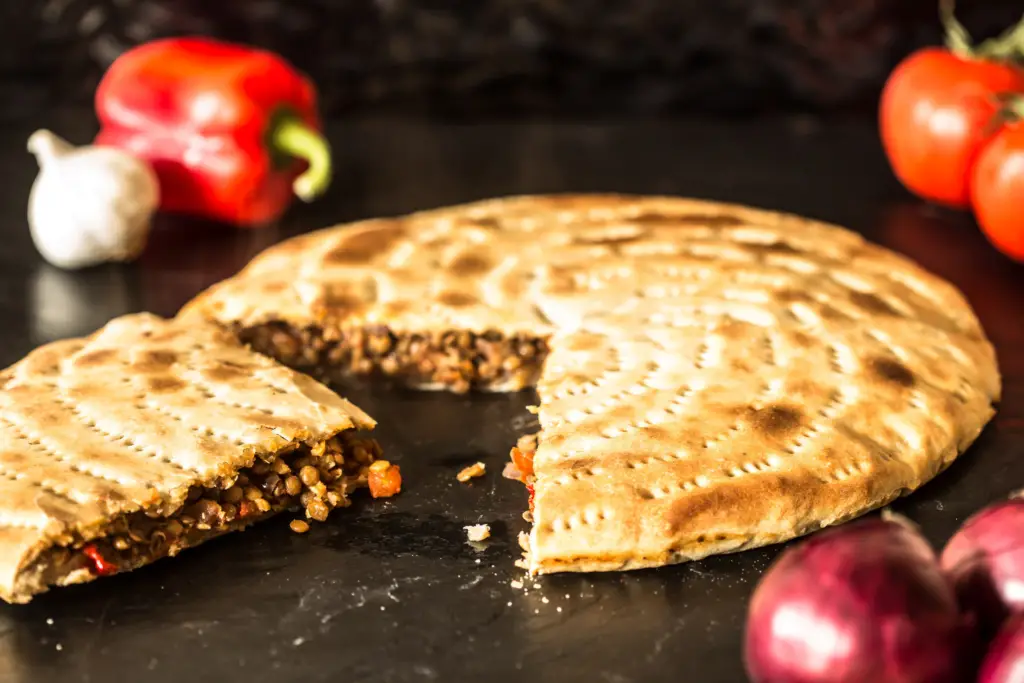
Ichlekli, also known to some as “Ishlekli,” is a cherished meat pie in the Turkmen culinary tradition. It’s reminiscent of the broader Central Asian practice of stuffing dough with meat, yet it distinctly stands out due to its flavors and preparation techniques.
The name ‘Ichlekli’ is derives from the Turkmen word ‘ich’ meaning inside or filling, denoting the inner meat stuffing. The outer crust is typically consists of dough, while the inner filling is a flavorful mix of minced meat, often combined with onions, spices, and sometimes other vegetables or herbs.
Historically, the Turkmen people led a nomadic or semi-nomadic lifestyle, roaming the vast terrains of Central Asia. Ichlekli emerged as a practical dish for these travelers – the meat provided the necessary protein, and the encased pastry ensured that the filling remained moist and flavorful, even if cooked over an open flame in the wilderness.
Turkmenistan Cuisine – Ingredients for Ichlekli
- Wheat flour
- Minced meat (lamb or beef)
- Onions
- Black pepper
- Salt
- Water
Turkmenistan food – How to prepare Ichlekli
- Make a dough using flour, water, and salt.
- For the filling, mix meat, finely chopped onions, salt, and pepper.
- Roll the dough.
- Place the filling in the center, and fold.
- Bake until crisp.
Serve Ichlekli hot, preferably with a side of fresh yogurt. A cold beer or fermented mare’s milk, known as “kumis,” complements the savory flavors.
Turkmenistan Cuisine – Khorovat (Grilled Meat)
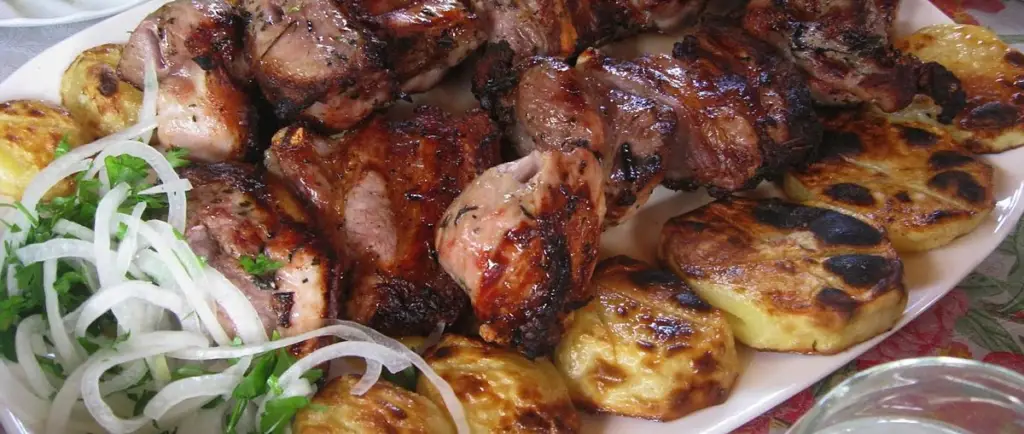
History and Background
“Khorovat” is a term common in various parts of Central Asia and the Caucasus, referring to grilled meat, similar to what many would identify as barbecue. In Turkmenistan, khorovat has roots in the nation’s nomadic traditions. Given the mobility of nomadic lifestyles, grilling meat over open flames became a practical and beloved method of cooking. It’s not just about the food; the act of grilling meat became a communal activity, symbolizing unity, celebration, and shared experiences.
Turkmenistan Cuisine – khorovat (grilled meat) Ingredients
- 2 lbs of lamb or mutton (preferably bone-in pieces or thick cuts)
- 4-5 garlic cloves, minced
- 1 large onion, grated or finely chopped
- 2 tablespoons of plain yogurt (optional, for added tenderness)
- 1 tablespoon of lemon juice or vinegar
- 1 teaspoon of ground black pepper
- 1 teaspoon of ground cumin
- 1 teaspoon of ground coriander
- Salt to taste
- Fresh herbs like cilantro or dill (for garnishing)
- Lemon or lime wedges (for serving)
khorovat (grilled meat) Recipe
Marinate the Meat
- In a large mixing bowl, combine the minced garlic, grated onion, yogurt (if using), lemon juice or vinegar, black pepper, cumin, coriander, and salt.
- Mix these ingredients thoroughly to form a paste.
- Coat the lamb or mutton pieces in this marinade, ensuring they are well-covered.
- Cover the bowl and let the meat marinate for at least 3-4 hours, preferably overnight in the refrigerator.
Prepare the Grill
- Heat your grill or barbecue to a medium-high heat. If using charcoal, ensure the coals are white-hot and spread evenly.
Grill the Meat
- Place the marinated meat pieces on the grill. Depending on the thickness and type of meat, grill each side for 5-7 minutes for medium-rare to medium, or longer if you prefer your meat more well-done.
- Turn the meat occasionally to ensure even cooking and to prevent burning.
Serve
- Once cooked to your desired doneness, remove the khorovat from the grill and let it rest for a few minutes.
- Garnish with fresh herbs, and serve with lemon or lime wedges on the side.
“Khorovat” is traditionally enjoyed with flatbreads and a side of fresh vegetables or salads. The smoky flavor of the grilled meat, combined with the aromatic spices, makes this dish a standout in Turkmenistan’s culinary repertoire.
Turkmenistan Cuisine – Plov

Plov, also known as pilaf, is a rice dish that transcends several cultures and countries, with each region adding its unique twist. In Turkmenistan, Plov holds an esteemed position, deeply ingrained in the nation’s culinary and cultural fabric.
The dish’s origins trace back to ancient cooking practices of Central Asia, where the combination of rice, meat, and vegetables cooked in a single pot made for a hearty, nutritious meal.
Turkmenistan’s plov main ingredient is long-grain rice, often mutton or beef, and the use of specific local ingredients, such as dried fruits or specific spices, giving it a distinct flavor profile. The Turkmen method often involves cooking the meat and rice in layers, allowing the flavors to meld together beautifully.
Turkmenistan Cuisine – Ingredients for Plov
- Basmati rice
- Lamb meat
- Onions
- Carrots
- Vegetable oil
- Salt
Turkmenistan Cuisine – How to prepare Plov
In a large pot, brown the meat. Add sliced onions and grated carrots. Once softened, add washed rice, water, and salt. Cook until the rice is tender.
Plov is best as a communal dish, allowing everyone to partake. Pair with a light red wine or black tea.
Turkmenistan Cuisine – Shashlik

Shashlik, or skewered and grilled cubes of meat, is an iconic dish that resonates across the vast terrains of Central Asia, the Caucasus, and even parts of Eastern Europe. Its simplicity—meat marinated, skewered, and grilled over open flames—bears testament to ancient culinary traditions where open-fire cooking was the norm.
In Turkmenistan, the practice of preparing Shashlik has deep-rooted historical significance, echoing the country’s nomadic past. The nomadic Turkmen tribes, roaming the vast deserts and steppes, relied heavily on livestock.
The need for a quick, nutritious, and flavorsome meal led to the evolution of Shashlik. The meat, often mutton or lamb in Turkmenistan, is marinated with local spices, ensuring that it remains tender and flavorful after being grilled.
Turkmenistan Cuisine – Ingredients for Shashlik
- Lamb or beef chunks
- Onions
- Vinegar
- Salt
- Pepper
Turkmenistan Cuisine – How to prepare Shashlik
Marinate meat with sliced onions, vinegar, salt, and pepper. Skewer the meat and grill until charred and juicy.
Serve Shashlik with fresh tomatoes and onions. A cold beer or a refreshing ayran, a yogurt drink, matches the dish’s smoky flavors.
Turkmenistan Cuisine – Turkmenistan manti
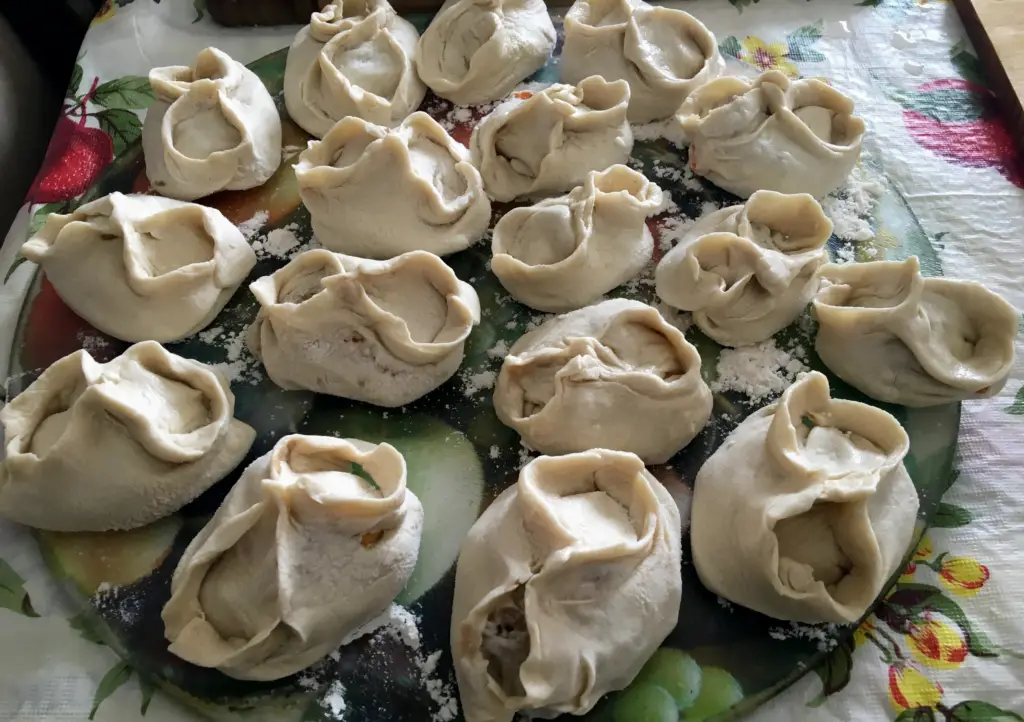
Turkmenistan Manti, delectable dumplings stuffed typically with meat and onions, is a dish that finds its roots in the ancient nomadic traditions of Central Asia. These dumplings, with their delicate wrappers and savory fillings, are believed to have been a convenient and hearty meal for the nomads traveling across the vast steppes of Central Asia, including Turkmenistan.
Turkmenistan Manti has been assimilated and adapted in a way that makes it uniquely Turkmen. While mutton and beef are common fillings, Turkmenistan Manti often incorporates ingredients like pumpkin or local spices, adding a distinct twist to the traditional recipe.
The process of making Turkmenistan Manti is meticulous and often communal, with families coming together to prepare large batches, emphasizing the importance of unity and shared labor.
Ingredients for Turkmenistan Manti
- Dough
- Minced meat
- Onions
- Salt
- Pepper
How to prepare Turkmenistan Manti
- Prepare a soft dough using flour, water, and salt.
- Mix meat with finely chopped onions, salt, and pepper for filling.
- Fill the dough pockets.
- Steam until cooked.
Turkmenistan Manti is best presented with a dollop of butter or sour cream on top. Serve with black tea or a light white wine.
Turkmenistan Cuisine – Baklava
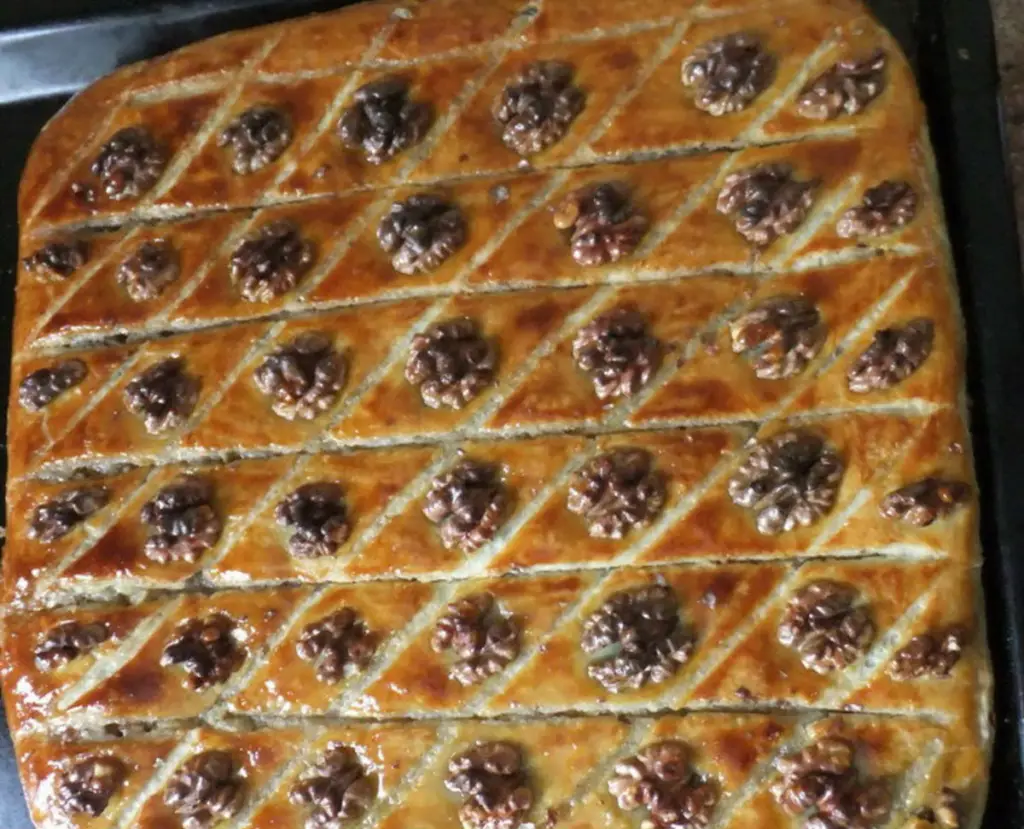
Baklava is a sumptuous, layered pastry made with thin phyllo dough, honey or syrup, and crushed nuts. It is a dessert with deep historical roots stretching across the Middle East, the Mediterranean, and Central Asia, including Turkmenistan.
Its origins are often debated, but what’s undeniable is the spread of its popularity across these regions, each adding its unique touch to this sweet masterpiece.
In Turkmenistan, the Baklava—while sharing similarities with its counterparts from neighboring countries—carries a distinct flavor. The Turkmen variation may incorporate local nuts, spices, and a particular method of layering or folding, which distinguishes it from others.
Given Turkmenistan’s position on the ancient Silk Road, it’s conceivable that Baklava, in some form, was introduced or adapted through centuries of cultural exchanges.
Turkmenistan Cuisine – Ingredients for Baklava
- Phyllo dough
- Mixed nuts
- Honey
- Butter
Turkmenistan Cuisine – How to prepare Baklava
Layer the dough sheets, brushing each with melted butter. Sprinkle nuts and drizzle honey. Repeat layers and bake until golden. Pour more honey when hot.
Serve Baklava in small squares, with a sprinkle of crushed pistachios on top. Pair with sweet black tea or coffee.
Turkmenistan Cuisine – Chak-Chak
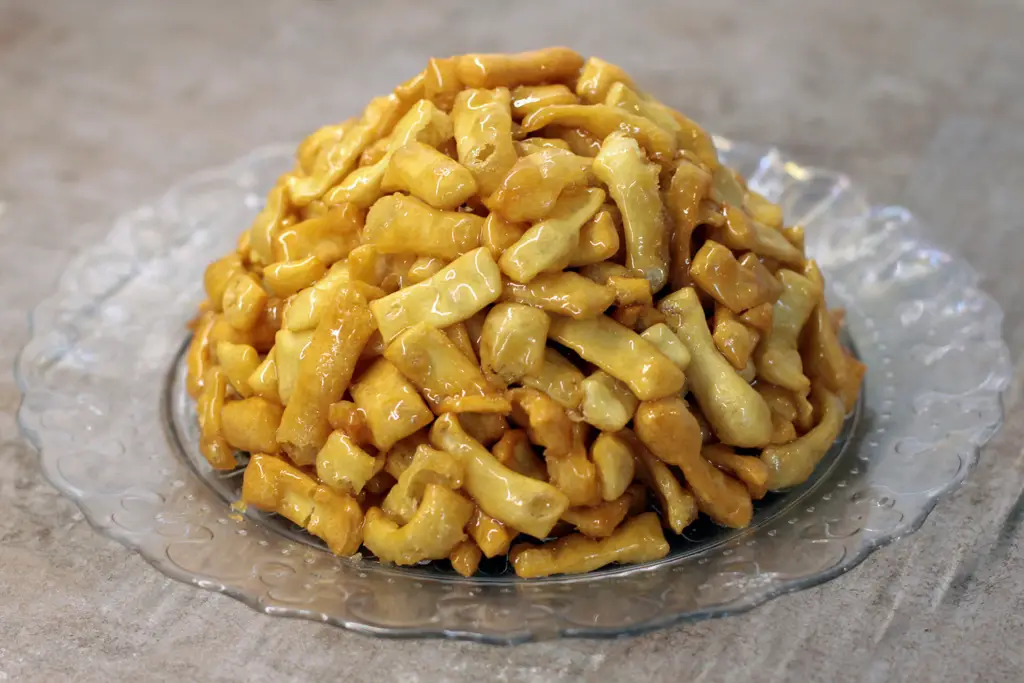
Chak-Chak, a delightful sweet treat, is predominantly known in Central Asia, particularly among Turkic-speaking nations. Comprising of deep-fried pieces of dough that are then drenched in honey or sugar syrup, this dessert carries the essence of simplicity, yet is packed with flavor.
The origins of Chak-Chak can be traced back to the nomadic traditions of Central Asia. As nomads traveled vast distances, they often carried ingredients that were non-perishable and could be transformed into meals with minimal effort.
Flour, honey, and oil were staples in their diet, and Chak-Chak emerged as a quick sweet dish that could be prepared using these ingredients.
In Turkmenistan, Chak-Chak is deeply cherished. Over the years, various iterations have been added to this base dessert, such as the introduction of nuts or dried fruits, each addition enriching the traditional treat.
Turkmenistan Cuisine – Ingredients for Chak-Chak
- Wheat flour
- Eggs
- Honey
- Vegetable oil (for frying)
Turkmenistan Cuisine – How to prepare Chak-Chak
Mix flour and eggs to form a dough. Roll and cut into small balls. Deep-fry until golden. In a bowl, mix the balls with warm honey, forming a mound.
Present Chak-Chak in a decorative plate, allowing it to cool. Serve with sweetened black tea or fresh fruit juices.
Conclusion
Turkmenistan’s cuisine offers a palate of flavors shaped by its rich history and traditions. From starters to desserts, each dish tells a story, making dining a delightful experience.
FAQ’s
What are the characteristics of the Food of Turkmenistan?
The food of Turkmenistan is a reflection of its rich cultural heritage and nomadic traditions. Traditional dishes include “plov” (rice pilaf with meat and vegetables), “manty” (dumplings filled with ground meat), and “ash” (a hearty soup).
The cuisine often incorporates ingredients like lamb, beef, and dairy products, highlighting the country’s agrarian roots.
What is the Turkmenistan National Dish?
Plov is the Turkmenistan national dish. It is a flavorful rice dish made with lamb or beef, carrots, onions, and spices like cumin and paprika.
The dish is cooked slowly to allow the flavors to meld together, resulting in a delicious and hearty meal that is enjoyed across the country.
What is the staple grain in Turkmenistan cuisine?
Rice is the staple grain, often used in dishes like Plov.
Is vegetarian food common in Turkmenistan?
While meat dominates, there are vegetarian dishes available, particularly during religious fasting periods.
What are common spices used?
Turkmen dishes are mildly spiced, commonly using black pepper, cumin, and coriander.
Is dairy prevalent in Turkmenistan cuisine?
Yes, dairy, especially yogurt, is a staple and used in various dishes and drinks.
What is the traditional drink to accompany meals?
Black tea and ayran are commonly consumed with meals.
Are Turkmen dishes very spicy?
No, they lean more towards being hearty and flavorful rather than overly spicy.
Food In Turkmenistan
Food in Turkmenistan is heavily influenced by its nomadic heritage and regional flavors. Traditional dishes include shashlik (grilled meat skewers), manty (dumplings filled with meat), and plov (rice pilaf with meat and vegetables).
Turkmen cuisine often incorporates dairy products like kurt (dried cottage cheese) and yarma (soured milk).

